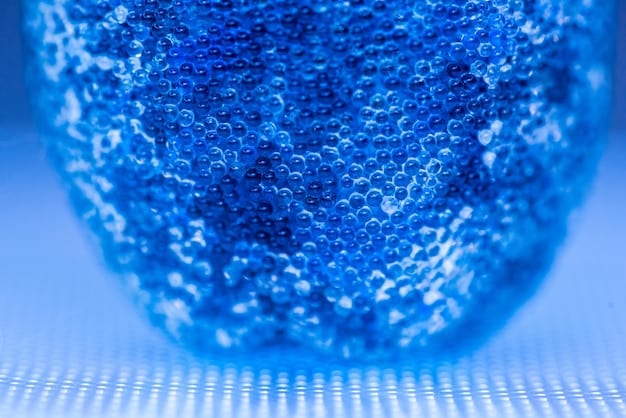Nanotechnology in Water Purification: Filters Reducing Contaminants by 95%

Nanotechnology in water purification, specifically through advanced filters, holds immense promise for significantly reducing contaminants, with new innovations potentially achieving greater than 95% removal efficiency for a broad spectrum of pollutants, marking a transformative leap in access to clean, safe drinking water.
In a world grappling with increasing water scarcity and contamination, the quest for efficient purification methods is more critical than ever. Traditional water treatment processes, while effective to a degree, often fall short in addressing emerging pollutants and micropollutants. This is where nanotechnology in water purification: can new filters reduce contaminants by 95%? comes into sharp focus, offering a groundbreaking approach to ensuring cleaner, safer water for communities worldwide.
The Dawn of Nano-Enabled Water Filtration: A Paradigm Shift
The rising global demand for clean water, coupled with the increasing complexity of waterborne contaminants, necessitates innovative solutions beyond conventional filtration methods. Nanotechnology, with its ability to manipulate matter at the atomic and molecular scales, offers an unparalleled opportunity to revolutionize water purification, providing filters capable of targeting pollutants previously deemed insurmountable. This section explores the fundamental principles behind nano-enabled water filtration and its potential to reshape public health and environmental sustainability.
The Unique Properties of Nanomaterials in Filtration
Nanomaterials exhibit extraordinary properties due to their extremely small size, typically ranging from 1 to 100 nanometers. This diminutive scale results in a disproportionately large surface area-to-volume ratio, significantly enhancing their reactivity and adsorptive capabilities. In water purification, these attributes are crucial for effective contaminant removal. The increased surface area provides more active sites for adsorption, where pollutants physically adhere to the nanoparticle’s surface. Furthermore, the unique electronic and optical properties of certain nanomaterials can facilitate catalytic degradation of organic pollutants, breaking them down into less harmful substances. Imagine a filter where each minuscule particle acts like a powerful magnet, selectively pulling out impurities.
Consider the remarkable advancements driven by these materials:
- Enhanced Adsorption: Nanoparticles’ vast surface area allows for superior binding of contaminants, including heavy metals and organic compounds, surpassing traditional adsorbents.
- Catalytic Degradation: Some nanomaterials, like titanium dioxide nanoparticles, can, when exposed to light, generate reactive oxygen species that break down persistent organic pollutants.
- Antimicrobial Efficacy: Silver and copper nanoparticles exhibit potent antimicrobial properties, effectively inactivating bacteria and viruses, thereby sterilizing water streams.
- Selective Separation: The tunable pore sizes and surface chemistries of nanomembranes allow for highly selective removal of specific contaminants, leaving beneficial minerals intact.
This combination of properties makes nanomaterials incredibly versatile in addressing a wide array of water quality challenges. They are not merely smaller versions of existing materials; rather, they possess fundamentally different and superior attributes that enable groundbreaking solutions. The transition from macro-scale to nano-scale engineering opens up new possibilities for filter designs that are both more efficient and more sustainable.
The precise control over the morphology and composition of nanomaterials is another critical factor. Researchers can design nanoparticles with specific shapes, sizes, and surface chemistries to selectively target particular contaminants, optimizing the filtration process. This bespoke engineering capability addresses the diverse nature of pollutants found in various water sources, from industrial effluents to agricultural runoff and urban wastewater. This level of precision was once aspirational, but with nanotechnology, it is becoming a tangible reality, pushing the boundaries of what is possible in water treatment.
The implications for global health are immense. Access to clean water is a fundamental human right, yet billions still lack it. Nanotechnology provides a pathway to cost-effective, scalable, and highly efficient water purification systems that can be deployed in remote areas or during disaster relief, changing lives by improving health outcomes and reducing waterborne diseases. This technological leap represents not just an incremental improvement but a transformative shift, offering hope for tackling one of humanity’s most pressing challenges.
Beyond the Hype: Assessing the 95% Contaminant Reduction Claim
The claim that new nano-filters can reduce contaminants by 95% or more is often met with a mix of excitement and skepticism. While impressive, achieving such a high reduction rate hinges on various factors, including the type of contaminants, filter design, and operational conditions. This section delves into the scientific basis of these claims, differentiating what is achievable today from future possibilities, and explores the nuances of performance metrics in real-world scenarios.
Specific Contaminants Targeted by Nanotechnology
Nanotechnology offers a versatile toolkit for tackling a broad spectrum of water contaminants. Different nanomaterials are engineered to address specific types of pollutants, from microscopic pathogens to recalcitrant chemical compounds. For instance, carbon-based nanomaterials like graphene and carbon nanotubes excel at adsorbing organic micropollutants, pharmaceuticals, and dyes due to their high surface area and tunable pore sizes. Metallic nanoparticles, particularly silver and copper, are renowned for their potent antibacterial and antiviral properties, effectively inactivating harmful microorganisms.
Consider the diverse applications across various contaminant classes:
- Heavy Metals: Nanoparticles composed of iron oxides or dendrimers can chelate and precipitate heavy metal ions like lead, mercury, and arsenic, removing them from water.
- Organic Pollutants: Carbon-based nanomaterials (graphene, carbon nanotubes) and photocatalytic nanoparticles (titanium dioxide) break down or adsorb pesticides, pharmaceuticals, and endocrine-disrupting chemicals.
- Microorganisms (Bacteria, Viruses, Protozoa): Silver, copper, and zinc oxide nanoparticles, along with specialized nano-membranes, can physically block or chemically inactivate a wide range of pathogens.
- Microplastics: Emerging research explores the use of nano-enabled filters to capture microplastic particles, which are increasingly recognized as an environmental and health concern.
The effectiveness against specific contaminants is often highly dependent on the nanomaterial’s surface chemistry, size distribution, and the method of its integration into the filter matrix. For example, a filter optimized for heavy metal removal might use different nanomaterials and configurations than one designed to remove viruses. The 95% reduction claim is more realistic when the filter is specifically designed and optimized for a defined set of contaminants under controlled conditions. This tailored approach is crucial for real-world applications where water sources can have highly variable contamination profiles.
Real-World Performance vs. Lab Conditions
Bridging the gap between laboratory-scale achievements and real-world implementation is a critical challenge for any emerging technology, and nanotechnology in water purification is no exception. In controlled lab settings, researchers can precisely control variables such as water pH, temperature, contaminant concentration, and flow rates, often leading to impressive removal efficiencies. These conditions are ideal for demonstrating the maximum potential of a nano-filter. However, real-world water sources are far more complex and dynamic.
Factors that can influence real-world performance include:
- Water Matrix Complexity: The presence of other dissolved solids, natural organic matter, and various ions can interfere with the binding sites on nanomaterials, reducing their efficiency.
- Fouling: Over time, filter membranes can become clogged with particulate matter, biofilms, or mineral scaling, leading to reduced flow rates and decreased contaminant removal.
- Scalability and Cost: Producing nano-filters at a mass scale while maintaining their performance and keeping costs competitive with traditional methods is a significant hurdle.
- Longevity and Regeneration: The lifespan of nano-filters and the feasibility of regenerating them to sustain high performance over extended periods are ongoing areas of research.
While a 95% reduction in certain contaminants may be achievable under specific, optimized conditions, maintaining this level of performance consistently in diverse real-world scenarios requires robust engineering and ongoing research. The objective is not just to achieve high removal rates once but to sustain them economically and reliably over the filter’s operational life. This involves developing anti-fouling strategies, improving filter regeneration techniques, and ensuring the long-term stability of the nanomaterials within the filter matrix. The research community is actively engaged in addressing these practical challenges to ensure that nano-enabled filtration lives up to its promise.
The Science Behind Nano-Scale Filtration Mechanisms
At its core, nanotechnology in water purification operates on principles that exploit the unique physical and chemical characteristics of materials at the nanoscale. These mechanisms allow for highly efficient removal of contaminants that are often too small to be captured by conventional filtration methods. Understanding these mechanisms is crucial for appreciating the revolutionary potential of nano-filters and for designing systems that push the boundaries of purification efficiency.
Adsorption: Maximizing Surface Interactions
Adsorption is a fundamental mechanism in nano-filtration, relying on the vast surface area of nanomaterials. Unlike absorption, where one substance is incorporated into another, adsorption involves the adhesion of molecules, atoms, or ions from a gas, liquid, or dissolved solid to a surface. Nanomaterials, with their extremely high surface area-to-volume ratio, provide an enormous number of active sites for contaminants to bind. Think of it like a sponge, but instead of soaking up water, the nanomaterial selectively binds specific pollutants to its surface.
Commonly used nanomaterials for adsorption include:
- Carbon Nanotubes (CNTs): These cylindrical carbon structures have exceptionally high surface areas and highly tunable pore sizes, making them excellent for adsorbing organic molecules and heavy metal ions.
- Graphene Oxide (GO) and Reduced Graphene Oxide (rGO): These 2D materials offer vast surface areas and can be functionalized to specifically target various pollutants, including dyes, pharmaceuticals, and metallic ions.
- Metal-Organic Frameworks (MOFs): MOFs are porous crystalline materials with enormous surface areas and customizable pore structures, allowing for highly selective adsorption of gases, liquids, and specific contaminants.
- Nano-sized Metal Oxides: Materials like aluminum oxide (Al2O3) and iron oxide (Fe2O3) nanoparticles can effectively adsorb heavy metals and certain anions due to their surface charge and chemical reactivity.
The efficacy of adsorption is influenced by factors such as the surface chemistry of the nanomaterial, the electrostatic interactions between the nanomaterial and the contaminant, and the presence of competing ions in the water. Researchers meticulously engineer the surface properties of nanomaterials to optimize their affinity for target pollutants, ensuring efficient and selective removal. This precision engineering means that the filter isn’t just catching everything; it’s designed to specifically capture problematic substances.
Membrane Filtration: Precision Pore Sizing
Nano-membranes represent a significant leap in filtration technology, offering unprecedented precision in separating contaminants based on size exclusion. These membranes typically feature pores in the nanometer range, allowing water molecules to pass through while physically blocking larger contaminants like bacteria, viruses, and even some dissolved salts. This physical barrier mechanism provides a robust and reliable method for purification. The concept is akin to a very fine sieve, but at an incredibly small scale.
Key aspects of nano-membrane technology include:
- Nanofiltration (NF) Membranes: These membranes have pore sizes typically ranging from 1 to 10 nm. They are effective in removing multivalent ions (e.g., heavy metals), hardness, organic molecules, and most bacteria and viruses, while allowing monovalent ions and water to pass.
- Reverse Osmosis (RO) Membranes: Although not strictly “nano” in terms of pore size (they operate more on diffusion than physical pores), the principles of molecular separation are highly relevant. Advanced RO membranes integrate nanomaterials to improve permeability, reduce fouling, and enhance their contaminant rejection rates, even for some monovalent ions.
- Forward Osmosis (FO) Membranes: This emerging technology uses a draw solution to create an osmotic pressure gradient, pulling water across a semi-permeable membrane. Nano-engineered FO membranes can offer high rejection rates with reduced fouling compared to RO, making them suitable for challenging water sources.
- Electrospun Nanofiber Membranes: These membranes are created by electrospinning polymeric solutions into very fine fibers, resulting in highly porous structures with interconnected pores in the nano to sub-micron range, offering high flux and contaminant removal efficiency.
The integration of nanomaterials into membrane structures not only refines pore size but also enhances anti-fouling properties, improves mechanical strength, and enables self-cleaning capabilities. For example, hydrophilic nanomaterials can prevent the adhesion of organic foulants, extending the membrane’s lifespan and reducing maintenance requirements. This meticulous control over membrane morphology and surface chemistry is what allows nano-filters to achieve such high removal efficiencies for a diverse range of contaminants, making clean water accessible in ways previously thought impossible.
Challenges and Considerations for Widespread Adoption
Despite the incredible promise of nanotechnology in water purification, several significant challenges must be addressed before these advanced filtration systems can achieve widespread adoption. These include concerns related to cost, potential environmental impacts, and the longevity of nano-enabled solutions. Overcoming these hurdles will require continued research, innovative engineering, and effective policy frameworks.
Cost-Effectiveness and Scalability
One of the primary barriers to the widespread adoption of nano-filters is the current cost of production and implementation, especially when compared to conventional water treatment methods. The synthesis of many nanomaterials can be energy-intensive and require specialized equipment, leading to higher manufacturing costs. While the long-term benefits of enhanced purity and reduced health costs are evident, the initial capital investment can be prohibitive for many communities and industries.
Key cost-related considerations include:
- Material Synthesis: The complexity of synthesizing high-quality, uniform nanomaterials on a large scale can drive up production costs.
- Filter Fabrication: Integrating nanomaterials into functional filter membranes or systems requires sophisticated fabrication techniques that add to the overall expense.
- Operational Costs: While nano-filters might reduce energy consumption due to lower pressure requirements in some cases, the costs associated with filter replacement, regeneration, and disposal also play a role.
- Economy of Scale: As production scales up, costs are expected to decrease, but achieving this scale requires significant investment and market demand.
Furthermore, the scalability of nano-filter production is a complex issue. Moving from laboratory-scale prototypes to industrial-scale manufacturing demands robust and repeatable processes that maintain the integrity and performance of the nanomaterials. Ensuring consistent quality across millions of filter units is a significant engineering challenge. Overcoming these economic and scalability barriers is essential for making nano-enabled water purification accessible to all, not just those with significant resources. This involves exploring more sustainable and cost-effective synthesis methods, fostering public-private partnerships, and potentially offering incentives for early adoption.
Environmental Impact of Nanomaterials
While nanomaterials offer remarkable benefits for water purification, concerns exist regarding their potential environmental impact at the end of their operational life or if released inadvertently. The unique properties that make nanomaterials so effective in treating water could also pose risks if they accumulate in the environment. Understanding the fate and transport of spent nanomaterials is crucial for ensuring the overall sustainability of this technology.
Potential environmental concerns include:
- Release into Ecosystems: If nano-filters are not properly disposed of or if nanomaterials leach from the filters, they could enter aquatic or terrestrial environments, potentially affecting ecosystems.
- Toxicity: Some nanomaterials, particularly certain metallic nanoparticles, have shown toxicity to aquatic organisms (e.g., fish, algae) under specific experimental conditions. The long-term effects on complex ecosystems are still being studied.
- Bioaccumulation: There is a concern that nanomaterials could bioaccumulate in the food chain, although research on this topic is ongoing and results are varied depending on the specific nanomaterial.
- Lifecycle Assessment: A comprehensive lifecycle assessment from synthesis to disposal is needed to fully understand the environmental footprint of nano-enabled water purification systems.
To mitigate these risks, researchers are focusing on developing “green” synthesis methods for nanomaterials, designing filters that encapsulate nanomaterials securely to prevent leaching, and exploring effective methods for managing and recycling spent filters. The development of self-cleaning or regenerative nano-filters could also reduce the frequency of disposal. Responsible innovation in nanotechnology demands a proactive approach to environmental safety, ensuring that the solutions developed for water purification do not inadvertently create new environmental problems. Regulators worldwide are also beginning to develop guidelines for the safe handling and disposal of nanomaterials, aiming to balance innovation with environmental stewardship.
Regulatory Landscape and Safety Protocols
The emerging nature of nanotechnology in water purification means that the regulatory landscape is still evolving. Ensuring the safety of these advanced systems, both during operation and at the end of their lifecycle, is paramount. This section examines the current regulatory frameworks, industry standards, and the safety protocols being developed to foster responsible innovation and build public trust in nano-enabled water solutions.
Current Regulations and Future Outlook
Globally, regulatory bodies are grappling with how to effectively oversee the development, use, and disposal of nanomaterials. Unlike traditional chemicals, the unique properties of nanomaterials, such as their small size and high reactivity, often necessitate specific considerations regarding their potential health and environmental impacts. Currently, many countries rely on existing chemical regulations, with some adapting them to include nanomaterial-specific provisions.
Key aspects of the regulatory landscape include:
- OECD Initiatives: The Organisation for Economic Co-operation and Development (OECD) has been instrumental in coordinating international efforts to research the safety of nanomaterials and develop testing guidelines.
- EPA Guidelines: In the United States, the Environmental Protection Agency (EPA) evaluates nanomaterials under existing statutes like the Toxic Substances Control Act (TSCA), often requiring reporting for new nanomaterial substances.
- EU Frameworks: The European Union has adopted a more cautious approach, integrating nanomaterial considerations into regulations like REACH (Registration, Evaluation, Authorisation and Restriction of Chemicals) and considering specific labeling requirements.
- Drinking Water Standards: Regulatory agencies are beginning to assess if existing drinking water standards are sufficient to address potential risks from nanoparticles, both those intentionally used in treatment and those occurring as byproducts.
The future regulatory outlook is likely to involve a more integrated and specific approach to nanomaterials. This may include the development of specific test methods for nanotoxicology, clear guidelines on risk assessment, and mandates for lifecycle assessment of nano-enabled products. The goal is to create a regulatory environment that encourages innovation while rigorously protecting public health and the environment. This necessitates ongoing dialogue between scientists, industry, and policymakers to develop regulations that are both scientifically sound and practically implementable. Public acceptance will also hinge on transparent communication about the safety and efficacy of these technologies.
Ensuring Safe Deployment and Monitoring
Beyond national regulations, the safe deployment of nano-enabled water purification systems also relies on robust industry standards and continuous monitoring. Manufacturers bear a significant responsibility in ensuring their products are safe and perform as claimed, while users need clear guidelines for operation and maintenance. Ensuring public trust is equally as important as ensuring technical efficacy.
Essential safety protocols and monitoring practices entail:
- Material Characterization: Rigorous characterization of nanomaterials (size, shape, surface chemistry, stability) to understand their behavior and potential interactions in different environments.
- Leakage Prevention: Developing filter designs that securely encapsulate nanomaterials, minimizing the risk of their unintended release into treated water or the environment.
- End-of-Life Management: Establishing clear protocols for the safe disposal, recycling, or regeneration of spent nano-filters to prevent environmental contamination.
- Real-Time Monitoring: Implementing advanced sensors and monitoring systems to detect potential nanoparticle release and assess filter performance in real-time, allowing for immediate corrective action.
- Public Education: Transparent communication with the public about the benefits, risks, and safety measures associated with nano-enabled water purification technologies to foster informed acceptance.
Collaborative efforts between researchers, industry, and regulatory bodies are crucial for developing comprehensive safety frameworks that address the entire lifecycle of nano-enabled water treatment solutions. This includes conducting thorough risk assessments, developing standardized testing methods, and ensuring that any potential risks are communicated clearly and responsibly to the public. By prioritizing safety and transparency, the water industry can build confidence in nanotechnology as a vital tool for ensuring access to clean and safe drinking water for future generations.
The Future of Water Purification: Bridging Innovation with Implementation
The journey of nanotechnology in water purification is still in its early stages, yet its trajectory suggests a future where clean water is more accessible and sustainable than ever before. Bridging the gap between groundbreaking innovation and widespread, equitable implementation will define the impact of this technology. This section looks ahead, exploring emerging trends, potential breakthroughs, and the collaborative efforts needed to realize the full promise of nano-enabled water purification.
Emerging Trends and Next-Generation Nano-Filters
The field of nanotechnology is evolving rapidly, with new materials and applications constantly emerging. The next generation of nano-filters promises even greater efficiencies, reduced energy consumption, and enhanced selectivity. Researchers are exploring novel materials and system designs that push the boundaries of current capabilities.
Future trends and innovations include:
- Bio-inspired Nanomaterials: Designing nanomaterials that mimic biological structures and processes, such as aquaporin-like membranes for ultra-efficient water transport and filtration.
- Self-Healing and Self-Cleaning Filters: Developing filters with intrinsic mechanisms to repair damage or prevent fouling, significantly extending their lifespan and reducing maintenance needs.
- Modular and Decentralized Systems: Creating compact, scalable nano-filter units that can be deployed in remote communities, disaster zones, or individual households, fostering water independence.
- AI and IoT Integration: Incorporating artificial intelligence and Internet of Things (IoT) sensors to enable real-time monitoring, predictive maintenance, and optimization of filter performance.
- Sustainable Nanomaterial Synthesis: Focusing on environmentally friendly and economically viable methods for producing nanomaterials, reducing their environmental footprint.
These advancements aim not only to improve filtration performance but also to address practical challenges like filter longevity, energy efficiency, and ease of deployment. The focus will be on creating smart, adaptive systems that can respond to varying water quality conditions and operate with minimal human intervention. Imagine a world where every household has a small, efficient, and intelligent nano-filter that ensures pristine drinking water, regardless of the source.
Global Impact and Policy Implications
The widespread adoption of nano-enabled water purification technologies could have profound global impacts, particularly in regions facing acute water scarcity and contamination. It offers a pathway to sustainable water management, improved public health, and economic development. However, realizing this potential requires supportive policies, international collaboration, and equitable access.
Key global impacts and policy considerations involve:
- Enhanced Water Security: Providing effective solutions for treating diverse water sources, including wastewater and brackish water, increasing available freshwater resources globally.
- Reduced Waterborne Diseases: Significantly lowering the incidence of illnesses caused by contaminated water, especially in developing regions, thereby improving public health outcomes and reducing healthcare burdens.
- Economic Growth: Creating new industries and jobs in the development, manufacturing, and deployment of advanced water treatment technologies.
- International Cooperation: Fostering global partnerships to share knowledge, best practices, and technological innovations, ensuring that nano-enabled solutions benefit all nations.
- Equitable Access: Developing policies and funding mechanisms to ensure that these advanced technologies are accessible and affordable for all communities, regardless of their economic standing.
Ultimately, the future of water purification lies in a multi-faceted approach that combines scientific ingenuity with strategic implementation. Nano-filters represent a critical component of this future, holding the potential to provide clean, safe, and abundant water for generations to come. By addressing the current challenges and diligently pursuing responsible innovation, society can harness the power of nanotechnology to solve one of humanity’s most pressing environmental and health challenges, ensuring a sustainable water future for all. This journey demands continuous research, regulatory foresight, and a collective commitment to leveraging science for societal good.
| Key Point | Brief Description |
|---|---|
| 🔬 Nano-Filter Potential | New nano-filters show promise for 95%+ contaminant reduction, addressing challenging pollutants. |
| 💡 How They Work | Utilize large surface area for adsorption and precise pore sizing in membranes for separation. |
| 🚧 Current Challenges | High costs, scalability issues, and potential environmental impacts need careful management. |
| 🧪 Regulatory & Safety | Evolving regulations and safety protocols are crucial for safe long-term deployment and public trust. |
Frequently Asked Questions about Nanotechnology in Water Purification
▼
Nanotechnology excels at removing a wide range of contaminants, including heavy metals (e.g., lead, arsenic), organic pollutants (e.g., pesticides, pharmaceuticals), bacteria, viruses, and even emerging micropollutants. Different nanomaterials, like graphene or silver nanoparticles, are specifically engineered to target various types of impurities, providing highly effective and specialized filtration against diverse threats, often surpassing traditional methods.
▼
The safety of nano-filters for drinking water is a primary focus of ongoing research and regulation. When properly designed and manufactured, with nanomaterials securely embedded to prevent leaching, they are considered safe. Regulatory bodies are developing guidelines to ensure safe deployment and disposal, emphasizing the need for rigorous testing and monitoring to prevent any inadvertent release of nanoparticles into the treated water or environment.
▼
Nano-filtration offers significant advantages over traditional methods by targeting contaminants at a much finer scale. It provides higher removal efficiencies for smaller particles, viruses, and emerging chemical pollutants that often bypass conventional filters. While traditional methods like activated carbon are effective for larger impurities, nano-filters offer superior precision, potentially leading to purer water and reducing the need for multiple treatment stages, due to their unique properties and mechanisms.
▼
Despite their promise, widespread adoption faces challenges, primarily related to cost-effectiveness and scalability of production. The current manufacturing processes for nanomaterials can be expensive. Additionally, ensuring their long-term stability and managing their environmental impact at the end of their lifecycle are key considerations. Research is actively addressing these issues to make nano-filters more affordable, durable, and environmentally sound for global implementation.
▼
Achieving 95% or greater contaminant reduction with nano-filters is highly plausible, especially under optimized conditions and for specific types of pollutants. Laboratory results often demonstrate these high efficiencies. In real-world applications, performance can vary based on water source complexity and filter maintenance. Continued advancements in filter design, anti-fouling technologies, and integration with smart systems aim to consistently deliver these high removal rates in diverse environments, making this target increasingly achievable.
Conclusion: Paving the Way for a Water-Secure Future
The journey into nanotechnology in water purification: can new filters reduce contaminants by 95%? reveals a profound transformation in our approach to clean water access. While the promise of achieving 95% or greater contaminant reduction is ambitious, scientific advancements and engineering innovations are steadily bringing this goal within reach. The unique properties of nanomaterials, from their vast surface areas for adsorption to their precise pore sizes for physical filtration, offer an unparalleled toolbox for tackling an increasingly complex array of waterborne threats. Addressing the challenges of cost, scalability, and environmental impact remains crucial, demanding concerted efforts from researchers, industry, and policymakers. As regulatory frameworks evolve and safety protocols strengthen, nano-enabled water purification systems are poised to play a pivotal role in ensuring global water security, safeguarding public health, and fostering a sustainable future where clean water is not a luxury, but a reality for all.





